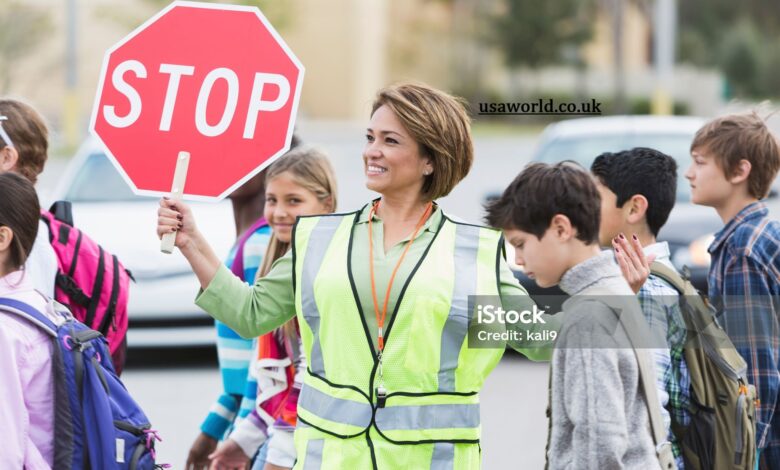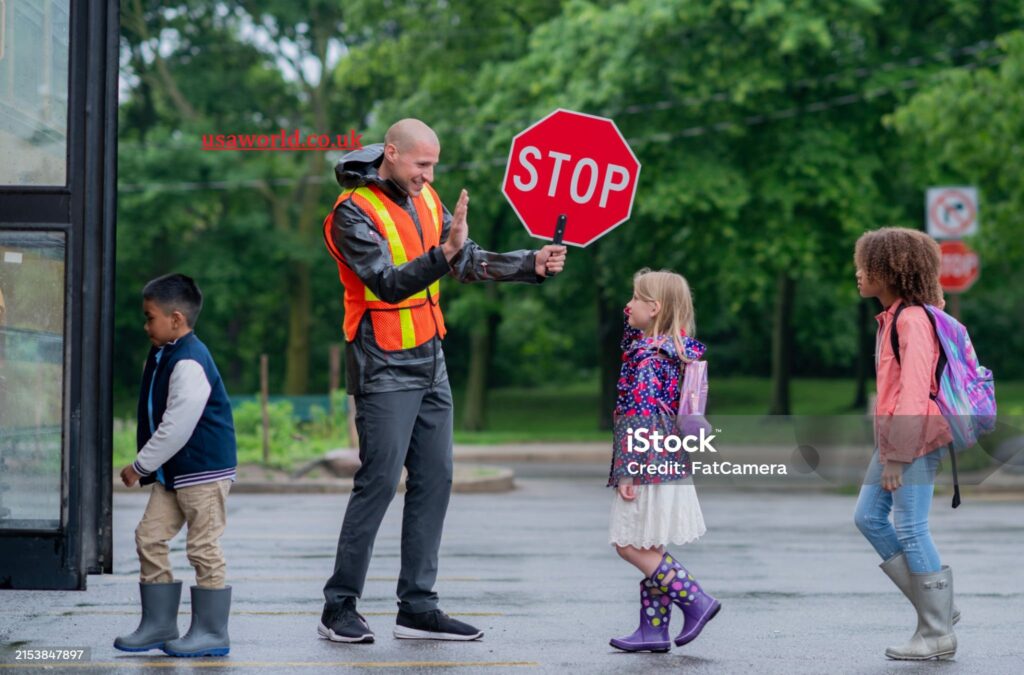The Crossing Guard: A Quiet Guardian of Our Streets

Introduction: More Than Just a Job
The crossing guard when we think about road safety, we often imagine traffic lights, signs, or police officers. Yet, tucked into the daily rhythm of neighborhoods and school zones is a figure who seems almost invisible until you truly notice them—the crossing guard. They stand at intersections with bright vests, raised stop signs, and a steady sense of authority, ensuring that pedestrians, particularly children, cross the street safely. On the surface, it looks like a simple task: hold up a sign, wave some cars to stop, and escort people across. But in reality, being a crossing guard is far more layered. It’s a blend of responsibility, intuition, human connection, and courage.
The title “crossing guard” might sound humble, but the role holds deep significance in communities. They aren’t just managing traffic; they’re safeguarding futures, one step at a time. Think about it: one careless driver, one distracted pedestrian, and a day could change forever. The crossing guard stands as the silent barrier between chaos and order. Their work reminds us that safety is not an automated system alone—it’s a human effort, one that requires presence, watchfulness, and care.
Interestingly, while crossing guards exist in nearly every part of the world, the way communities perceive them often varies. Some people treat them as casual helpers, while others revere them as essential protectors. Regardless of perception, their role shapes public safety in ways that go unnoticed—until the day their absence is felt.
In many ways, the crossing guard symbolizes the value of consistency. Rain or shine, cold mornings or blazing afternoons, they are there. They become part of the daily landscape, a constant figure reminding us that safety is something we must practice, not just assume.
The Origins of the Crossing Guard Role

The concept of the crossing guard has been around longer than most people think. It began not as an official job but as a community-driven effort. In the early 20th century, when automobiles first began to dominate streets, the rise in accidents involving pedestrians—especially children—sparked concern. Schools and neighborhoods realized they needed a human buffer between vehicles and vulnerable walkers. Thus, volunteers, often parents or community elders, began stepping into the role of traffic protectors.
Gradually, this volunteer spirit formalized into a recognized civic job. By mid-century, many cities had official crossing guard programs. The iconic reflective vest, whistle, and handheld stop sign became tools of the trade. These symbols were more than accessories; they became signals of authority. Drivers were expected to comply, and pedestrians found reassurance in the presence of someone visibly dedicated to their safety.
The historical roots of crossing guards also reflect how society views responsibility. While technology has advanced—traffic lights, crosswalk sensors, and even AI-driven cars—many communities continue to rely on human crossing guards. Why? Because machines can’t always read intent, facial expressions, or urgency. A child dashing toward the street requires instant judgment, something only a human can provide.
Today, crossing guards remain deeply tied to schools, but their presence extends beyond that. Busy urban neighborhoods, small-town junctions, and even festivals employ them. Their history proves something timeless: no matter how advanced traffic management becomes, there will always be value in a watchful human eye.
A Day in the Life of a Crossing Guard
To outsiders, a crossing guard’s day may seem repetitive, even monotonous. Yet, ask anyone who has done the job, and they will tell you: no two days are ever the same. The role demands alertness, patience, and adaptability. A typical day begins early. Long before students arrive at school, the guard is already stationed, assessing the morning traffic flow.
The work involves more than simply holding a sign. A crossing guard must read the rhythm of cars, predict potential risks, and manage pedestrians who may be distracted by phones or chatter. Every decision is split-second but can have life-altering consequences. The position requires a kind of hyper-awareness—scanning not just for moving vehicles, but also for body language cues: a child shifting their backpack, a cyclist swerving too close, or a driver showing signs of impatience.
The social aspect of the job is equally profound. Guards often become fixtures in their communities, recognized by children and parents alike. They exchange greetings, share quick conversations, and sometimes serve as a confidant for nervous kids heading to school. This human connection transforms the job from mere traffic management into community building. For many children, the crossing guard is the first adult outside their family they interact with daily—a reassuring figure of safety and kindness.
When the afternoon shift arrives, the work repeats—but in reverse. Students are tired, drivers are often rushing home, and the atmosphere feels less predictable. It’s in these hours that crossing guards often experience their most challenging moments, yet they persist. Their sense of duty is simple yet profound: everyone deserves to get home safely.
The Psychological Weight of Responsibility
What makes the role of the crossing guard extraordinary is not only what they do, but what they carry. The psychological weight of knowing that lives depend on your decisions is immense. Unlike many jobs, mistakes here are not measured in numbers or paperwork—they’re measured in human safety. That awareness stays with guards every moment they stand on duty.
This responsibility demands not only vigilance but resilience. It’s easy to underestimate how draining constant focus can be. Hours of standing in varying weather, never letting your mind drift, requires a discipline similar to that of a watchman. While others walk past without thought, the guard must remain anchored in attentiveness. It’s a quiet, unseen form of stress management.
Yet, many crossing guards embrace this weight with pride. They view their role not as burdensome, but as meaningful. There is dignity in knowing you prevent accidents before they happen. Even if no one thanks them, guards know they’ve safeguarded countless lives simply by being present.
This sense of unseen heroism is perhaps what makes the role so unique. It embodies the truth that society often runs smoothly not because of grand gestures, but because of small, consistent acts of care that prevent disaster. Crossing guards are living proof of that philosophy.
The Symbolism of the Crossing Guard
Beyond the practical duties, the crossing guard holds symbolic weight in modern culture. They represent order in the midst of chaos, caution in the face of speed, and community in an age of isolation. Just as a lighthouse warns ships of danger, the crossing guard warns drivers and pedestrians alike to slow down, to be mindful, to act with care.
In literature and film, crossing guards have occasionally been depicted as metaphors—ordinary individuals performing extraordinary roles without recognition. Their presence reminds us of the unseen labor that keeps society functional. They are neither police officers nor teachers, yet they bridge both worlds: enforcing rules while guiding the young.
Symbolically, the crossing guard embodies patience. They wait, watch, and act only when necessary. In a world obsessed with speed, they are the reminder that safety and mindfulness matter more than haste. Their role encourages drivers to pause, to recognize the value of a human life over the urgency of reaching a destination.
This symbolism makes the crossing guard more than a civic role; it makes them a moral compass on our streets. They stand as silent advocates for caution, care, and community. In their presence, even the most distracted driver is forced to slow down and acknowledge that there are lives more important than deadlines.
Conclusion: A Role Worth Remembering
The crossing guard may not wear a badge of honor, but their contribution to society is undeniable. They are guardians of safety, builders of trust, and symbols of patience in an impatient world. Their presence protects not only individuals but also the fragile sense of community that modern life often erodes.
In a time when technology often overshadows human roles, crossing guards remind us that empathy, instinct, and human judgment cannot be replaced by machines. They stand at the literal crossroads of life, ensuring that futures are not cut short by carelessness.
So, the next time you see a crossing guard, take a moment to recognize the quiet bravery in what they do. They may not be in the headlines, but they are the reason children get to school safely, parents feel reassured, and communities continue to function. The crossing guard may be ordinary in appearance, but in truth, they are extraordinary in purpose.



